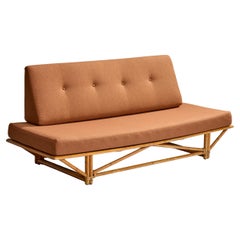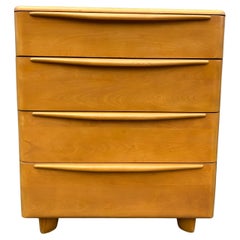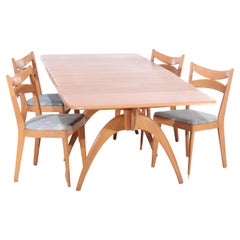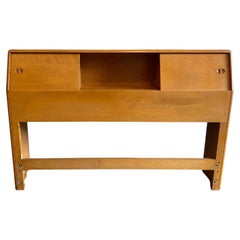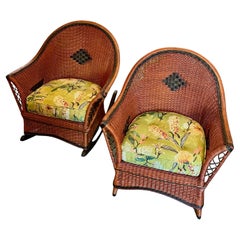Heywood-Wakefield Co. Furniture
Created by the 19th-century merger of two venerable Massachusetts furniture makers, Heywood-Wakefield was one of the largest and most successful companies of its kind in the United States. In its early decades, the firm thrived by crafting affordable and hugely popular wicker pieces in traditional and historical styles. In the midst of the Great Depression, however, Heywood-Wakefield reinvented itself, creating instead the first modernist furniture — chairs, tables, dressers and more — to be widely embraced in American households.
The Heywoods were five brothers from Gardner, Massachusetts, who in 1826 started a business making wooden chairs and tables in their family shed. As their company grew, they moved into the manufacture of furniture with steam-bent wood frames and cane or wicker seats, backs and sides.
In 1897, the Heywoods joined forces with a local rival, the Wakefield Rattan Company, whose founder, Cyrus Wakefield, got his start on the Boston docks buying up lots of discarded rattan, which was used as cushioning material in the holds of cargo ships, and transforming it into furnishings. The conglomerate initially did well with both early American style and woven pieces, but taste began to change at the turn of the 20th century and wicker furniture fell out of fashion.
In 1930, Heywood-Wakefield brought in designer Gilbert Rohde, a champion of the Art Deco style. Before departing in 1932 to lead Herman Miller — the prolific Michigan manufacturer that helped transform the American home and office — Rohde created well-received sleek, bentwood chairs for Heywood-Wakefield and gave its colonial pieces a touch of Art Deco flair.
Committed to the new style, Heywood-Wakefield commissioned work from an assortment of like-minded designers, including Alfons Bach, W. Joseph Carr, Leo Jiranek and Count Alexis de Sakhnoffsky, a Russian nobleman who had made his name in Europe creating elegant automotive body designs.
In 1936, the company introduced its “Streamline Modern” group of furnishings, presenting a look that would define the company’s wares for another 30 years. The buoyantly bright, blond wood — maple initially, later birch — came in finishes such as amber “wheat” and pink-tinted “champagne.” The forms of the pieces, at once light and substantial, with softly contoured edges and little adornment beyond artful drawer pulls and knobs, were featured in lines with names such as “Sculptura,” “Crescendo” and “Coronet.” It was forward-looking, optimistic and built to last — a draw for middle-class buyers in the Baby Boom years.
By the 1960s, Heywood-Wakefield began to be seen as “your parents’ furniture.” The last of the Modern line came out in 1966; the company went bankrupt in 1981. The truly sturdy pieces have weathered the intervening years well, having found a new audience for their blithe and happy sophistication.
Find vintage Heywood-Wakefield desks, vanities, tables and other furniture for sale on 1stDibs.
1950s American Mid-Century Modern Vintage Heywood-Wakefield Co. Furniture
Velvet, Rattan, Oak
1950s American Mid-Century Modern Vintage Heywood-Wakefield Co. Furniture
Maple
20th Century Heywood-Wakefield Co. Furniture
Birch
1950s American Mid-Century Modern Vintage Heywood-Wakefield Co. Furniture
Maple
1910s American Arts and Crafts Vintage Heywood-Wakefield Co. Furniture
Upholstery, Wicker, Reed, Wood
Mid-20th Century Mid-Century Modern Heywood-Wakefield Co. Furniture
Birch
1950s American Mid-Century Modern Vintage Heywood-Wakefield Co. Furniture
Maple
Mid-20th Century American Mid-Century Modern Heywood-Wakefield Co. Furniture
Maple
1940s American Mid-Century Modern Vintage Heywood-Wakefield Co. Furniture
Fabric, Walnut
Late 19th Century Unknown Victorian Antique Heywood-Wakefield Co. Furniture
Wicker
Mid-20th Century American Mid-Century Modern Heywood-Wakefield Co. Furniture
Wood
1930s American Modern Vintage Heywood-Wakefield Co. Furniture
Maple
Mid-20th Century American Mid-Century Modern Heywood-Wakefield Co. Furniture
Upholstery, Bamboo
Mid-20th Century American Mid-Century Modern Heywood-Wakefield Co. Furniture
Cut Glass, Mirror, Maple
1950s American Mid-Century Modern Vintage Heywood-Wakefield Co. Furniture
Rattan, Oak
Mid-20th Century American Mid-Century Modern Heywood-Wakefield Co. Furniture
Wood
1960s American Mid-Century Modern Vintage Heywood-Wakefield Co. Furniture
Formica, Wood
Mid-20th Century American Mid-Century Modern Heywood-Wakefield Co. Furniture
Birch
1920s American Art Deco Vintage Heywood-Wakefield Co. Furniture
Upholstery, Rattan, Reed, Wood
Mid-20th Century American Mid-Century Modern Heywood-Wakefield Co. Furniture
Glass, Birch, Maple
Mid-20th Century American Mid-Century Modern Heywood-Wakefield Co. Furniture
Maple
Mid-20th Century American American Colonial Heywood-Wakefield Co. Furniture
Maple
Late 19th Century American Late Victorian Antique Heywood-Wakefield Co. Furniture
Wicker
Mid-20th Century American Mid-Century Modern Heywood-Wakefield Co. Furniture
Wood
1950s American Mid-Century Modern Vintage Heywood-Wakefield Co. Furniture
Fabric, Wood
1950s American Mid-Century Modern Vintage Heywood-Wakefield Co. Furniture
Upholstery, Maple
1950s American Vintage Heywood-Wakefield Co. Furniture
Teak
Mid-20th Century American Mid-Century Modern Heywood-Wakefield Co. Furniture
Bamboo
1950s American Vintage Heywood-Wakefield Co. Furniture
Upholstery, Wood
1920s American Art Deco Vintage Heywood-Wakefield Co. Furniture
Wicker, Rattan, Reed
1890s American Victorian Antique Heywood-Wakefield Co. Furniture
Wicker, Beads
Mid-20th Century American Mid-Century Modern Heywood-Wakefield Co. Furniture
Cane, Wood
Mid-19th Century American Victorian Antique Heywood-Wakefield Co. Furniture
Metal
1970s American Mid-Century Modern Vintage Heywood-Wakefield Co. Furniture
Wood
Mid-20th Century American Mid-Century Modern Heywood-Wakefield Co. Furniture
Mirror, Birch
Late 19th Century American Victorian Antique Heywood-Wakefield Co. Furniture
Wicker
Early 20th Century American Other Heywood-Wakefield Co. Furniture
Fabric, Wicker, Reed, Wood
Mid-20th Century American Mid-Century Modern Heywood-Wakefield Co. Furniture
Brass
Late 20th Century American Mid-Century Modern Heywood-Wakefield Co. Furniture
Brass
Mid-20th Century American Mid-Century Modern Heywood-Wakefield Co. Furniture
Wood, Birch, Maple
20th Century American Mid-Century Modern Heywood-Wakefield Co. Furniture
Maple
1940s American Mid-Century Modern Vintage Heywood-Wakefield Co. Furniture
Birch
Mid-20th Century American Mid-Century Modern Heywood-Wakefield Co. Furniture
Hardwood, Maple
1960s American Vintage Heywood-Wakefield Co. Furniture
Steel
1930s American Art Deco Vintage Heywood-Wakefield Co. Furniture
Plywood, Maple
1950s American Mid-Century Modern Vintage Heywood-Wakefield Co. Furniture
Glass, Maple
1890s American Victorian Antique Heywood-Wakefield Co. Furniture
Wicker
Early 20th Century American Heywood-Wakefield Co. Furniture
Wicker
1960s American Mid-Century Modern Vintage Heywood-Wakefield Co. Furniture
Maple
1960s American Mid-Century Modern Vintage Heywood-Wakefield Co. Furniture
Faux Leather, Birch
1950s American Mid-Century Modern Vintage Heywood-Wakefield Co. Furniture
Wood
Mid-20th Century American Mid-Century Modern Heywood-Wakefield Co. Furniture
Metal
1960s American Mid-Century Modern Vintage Heywood-Wakefield Co. Furniture
Upholstery, Wood
1960s American Mid-Century Modern Vintage Heywood-Wakefield Co. Furniture
Faux Leather, Maple
1950s American Mid-Century Modern Vintage Heywood-Wakefield Co. Furniture
Maple
Mid-20th Century North American Mid-Century Modern Heywood-Wakefield Co. Furniture
Wood
1960s American Mid-Century Modern Vintage Heywood-Wakefield Co. Furniture
Faux Leather, Maple
1950s American Mid-Century Modern Vintage Heywood-Wakefield Co. Furniture
Maple
1920s American Art Deco Vintage Heywood-Wakefield Co. Furniture
Wicker, Rattan, Reed
1920s American Art Deco Vintage Heywood-Wakefield Co. Furniture
Reed, Rattan, Wicker, Upholstery
Heywood-wakefield Co. furniture for sale on 1stDibs.
Creators Similar to Heywood-Wakefield Co.
- 1stDibs ExpertApril 5, 2022Heywood-Wakefield furniture is an American brand founded in 1897. The mid-century modern furniture manufacturer uses sustainable, durable Northern Yellow birch, which gives its pieces a rich yellow color. Shop a collection of Heywood-Wakefield furniture from some of the world’s top sellers on 1stDibs.
- 1stDibs ExpertSeptember 23, 2024To identify a Heywood-Wakefield chair, you can first look for a maker's mark. Beginning in 1949, the manufacturer began affixing paper labels to the undersides of chair seats. These labels usually feature the brand name along with an eagle logo. Unfortunately, the paper labels tended to come loose over time, so not all chairs will feature them, and pieces produced before 1949 are usually unmarked. If you can't find a marking, examine the hardware that holds the chair together. Heywood-Wakefield typically used Phillips head screws, so the presence of other types of fasteners will usually indicate that a different manufacturer produced the chair. In addition, the maker only utilized solid wood to construct its chairs. If you see plywood or veneers, your chair is probably not a Heywood-Wakefield. Because it can be difficult to identify an unmarked chair on your own, you may wish to have a certified appraiser or knowledgeable antique dealer assist you. Explore a range of Heywood-Wakefield chairs on 1stDibs.
- 1stDibs ExpertApril 5, 2022Heywood Wakefield furniture is made of solid wood, which means the best approach to cleaning it is to use a damp cloth and a small amount of mild dish soap for clean-up. Do not get the wood overly wet or it can warp or wet spots may develop. Shop a collection of Heywood Wakefield furniture from some of the world’s top sellers on 1stDibs.
- 1stDibs ExpertFebruary 13, 2023Heywood-Wakefield closed in 1981 when the company went bankrupt. The furniture maker is well known for their rattan and wicker furniture as well as for their blond wood casegoods made from maple and birch wood. On 1stDibs, find a selection of Heywood-Wakefield furniture.
- 1stDibs ExpertFebruary 1, 2024To identify Heywood-Wakefield furniture, search for the maker's mark. You will typically find it on a paper label or stamped directly onto an inconspicuous part of the piece, such as under the seat or tabletop. Early pieces usually display the company's name on its own, while those manufactured after 1949 will often have an eagle logo along with the Heywood-Wakefield wordmark. If questions about authentication remain, a certified appraiser or experienced antiques dealer can assist you. Explore a diverse assortment of Heywood-Wakefield furniture on 1stDibs.
- 1stDibs ExpertFebruary 13, 2023To identify Heywood-Wakefield wicker furniture, look for the maker's mark. It will either be printed on a paper label or stamped onto the piece in an inconspicuous area like the bottom or back. Pieces made after 1949 normally have the company name positioned inside of an eagle. Earlier furnishings will likely just show the maker's name. If you're unsure whether a specific piece is authentic, a certified appraiser or experienced antique dealer can assist you. Shop a range of Heywood-Wakefield furniture on 1stDibs.
- 1stDibs ExpertApril 5, 2022Yes, Heywood-Wakefield uses solid wood to create its furniture. The lumber used for the designs is sustainable and harvested from farms in New Hampshire. You can shop a collection of Heywood-Wakefield furniture from some of the world’s top sellers on 1stDibs.
- 1stDibs ExpertFebruary 13, 2023Heywood-Wakefield started making furniture in 1897. The company formed from the merger of two rattan furniture manufacturers, Heywood Brothers and Wakefield Company. Both companies were in Massachusetts. On 1stDibs, find a collection of Heywood-Wakefield furniture.
- 1stDibs ExpertFebruary 13, 2023Heywood-Wakefield furniture was made from a variety of woods. However, the furniture maker's acclaimed blond wood casegoods were made from birch and maple wood. On 1stDibs, find a selection of Heywood-Wakefield furniture.
